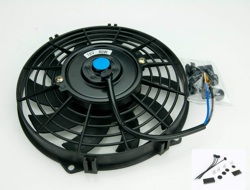
The purpose of this checklist is to describe the operation of the auxiliary cooling fan and provide a diagnostic procedure. The details herein apply to the Series III six-cylinder cars. Earlier cars may be similar. Twelve cylinder cars are wired differently.
The electric cooling fan is designed to come on at about 95C degrees and turn off at about 90C degrees. It may run after the engine/igntion has turned off to provide after-cooling. Unlike twelve cylinder cars, the fan on six cylinder models will not automatically come on when the air conditioner compressor is engaged.
The three main compenents are the control relay, a thermal switch, and the fan motor itself. The red control relay is mounted to the left of the radiator. The fan is forward of the radiator, low and to the left. The thermal switch is mounted nearly at the bottom of the right side radiator tank. When the coolant reaches 95C degrees the thermal switch closes and energizes the relay, thus powering the fan.
The circuit uses a applied voltage and diodes to "latch" the relay for engine-off after cooling. Diagnosis of the circuit requires only a volt meter or 12 volt test lamp and a jumper wire.
Here's a checklist to diagnose an inoperative electric fan:
1) First, check that the motor itself operates. Remove the connector from the relay and locate the terminals associated with the brown/green wire and the green/blue wire. The brown/green wire is constant battery voltage from fuse #1 in the headlight fuse panel. Check for voltage here with your test light. If no voltage, check for a blown fuse or a wiring fault between the brown/green wire and the fuse box. Assuming voltage is present, use a jumper wire to apply voltage from the brown/green wire to the green/blue wire which goes directly to the fan motor. You are bypassing the control circuit and the fan should operate .If it does go to Step 2. If it does not, the fan motor is faulty or not properly grounded. Check the ground wire from the fan and if it's Ok then replace the fan motor.
2) Now check the thermal switch. Unplug the harness to the switch and "jumper" the two harness connectors with the key "on". If the fan operates then you have a faulty thermal switch (assuming coolant temp is over 95C degrees at time of this check). If it does not, continue on....
3) Next check for ground at the black wire coming from terminal 86 of the relay. If not grounded then you have a wiring fault.
4) Check fuse #11 of the main fuse box. If the fuse is OK then we need to check for control voltage. A light green wire leaves the #11 fuse and goes to a diode in the harness. After the diode the wire becomes light green/orange and leads to the thermal switch. With key "on" check for voltage at the light green/orange wire to the thermal switch. If the voltage is present and all previous checks ar good, then you have a faulty relay. If no voltage here then you have a wiring fault between the fuse box and the thermal switch or a bad diode. (Diode location is a bit of a mystery on some cars and you'll just have to follow the harness till you find it. On my car it is forward of the radiator, left side, in a harness that runs approximately vertically behind the left headlights. You'll feel a lump in the harness as you check along. The diode is a one-way electric valve. With the key "on" voltage should be present at both sides of the diode).
What if the fan operates but does not cycle correctly ? Here we go...
1) If the fan operates at all times or won't turn off as expected even when the engine is cool, key "on" or "off", then the thermal switch is stuck closed or the relay is stuck in the latched mode. The "latch" capabilty works like this: Once the circuit is energized a voltage is applied to the green/blue wire connected to terminal 30/51 of the relay and the diode. This allows the fan to run for after-cooling with the key "off" until the thermal switch opens. So, unplug the thermal switch. If the fan continues to run then the relay is stuck. If it stops then you probably have a faulty thermal switch. I say "probably" because disconnecting the switch (interrupting the control voltage) may unstick the relay and give you a false impression that the relay is good... just a possibilty.
More notes: the purpose of the diodes is, in the event of key "off" after-cooling, to prevent the igntion feed circuit (associated with fuse #11) from being powered-up needlessly while the fan is running.
If you desire there is archive information on modifying the circuit so it operates like a 12 cylinder car--- fan comes on whenever the AC compressor is engaged.
















No comments have been posted yet...
Want to leave a comment or ask the owner a question?
Sign in or register a new account — it's free